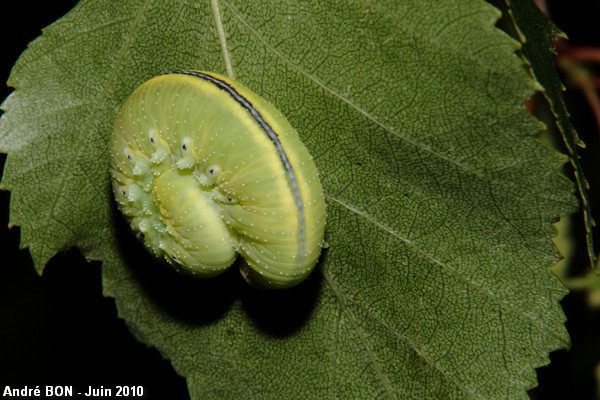


| Large Birch Sawfly (Cimbex femoratus (Linnaeus, 1758)) |



|
|
Scientific name: Cimbex femoratus (Linnaeus, 1758) Common name: Large Birch Sawfly French name: Cimbex du bouleau Order: Hymenoptera Family: Cimbicidae Wingspan : 20 to 22 mm. Biotope: The larvae grow on Birch trees. Geographic area: Palearctic region. Observation period : You can observe adults from May to July and larvae from July to September. They pupate in large brown reddish cocoons on the Birch tree. Adults will emerge at next spring. |
The Large Birch Sawfly is a large hymenoptera which is about the same size as a bumblebee. It has a heavy and noisy flight. It is completely black (sometimes reddish brown) and shiny, except the antennae and the tarsi which are yellow. The tip of the antennae is swollen. There is also one oval-shaped whitish mark on the upper side, just after the back of the thorax. The wings are bordered with black. The larvae, which can reach 50mm long, are green with yellowish white dots and one blue dorsal line bordered with black. The head is pale yellow with black eyes. You can observe them rolled up on Birch tree leaves. You can tell the larvae of the Cimbex genus apart with the species of the host tree: On Birch trees (Betula pubescens,Betula pendula) you can find Cimbex femoratus. On Willows (Salix caprea, Salix alba, Salix fragilis) and on Poplars (Populus tremula), you can find Cimbex luteus. |
| [To know more about the Large Birch Sawfly] [Next picture] [Top] |

|
Here is the typical position of the larva, rolled up on the centre of a Birch tree's leaf. |
| [To know more about the Large Birch Sawfly] [Next picture] [Previous picture] [Top] |

|
Here you can see the white dots and the blue dorsal line bordered with black. |
| [To know more about the Large Birch Sawfly] [Previous picture] [Top] |

|
I have always observed this larva sitting in this position. Is it only active during the night? I have not seen any visible damage to the foliage in the close vicinity. |